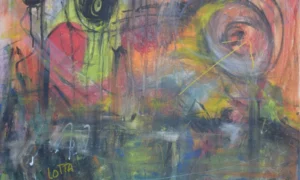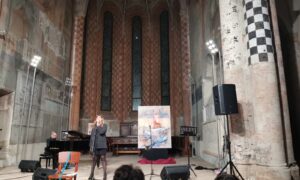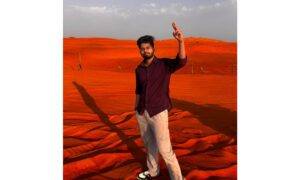Only those who inhabit the fracture can generate form. With this poetic statement begins Maurizio D’Andrea’s new artistic journey, The Generative Solitude: a cycle of works that explores solitude not as isolation, but as an energetic field of imagination — an invisible womb in which painting becomes a psychic experience and an inner transformation.
In an era when the image is endlessly consumed and replicated, D’Andrea restores painting to its original condition: silence, waiting, necessity. Solitude, in his vision, is not absence but dense presence — the place where form happens, where gesture becomes a non-conceptual form of knowledge. His canvases do not narrate; they breathe. They are landscapes of the soul, crossed by tensions, memories, and primordial impulses, as if color itself contained a pre-linguistic language, older than thought.
The Matter of Silence
In his recent works — Vento della Mente (Wind of the Mind), Futuro (Question Mark), Istinti (Instincts), Affronto (Confront), and the Mi.R series — D’Andrea turns pictorial matter into a dynamic theatre. Color does not describe; it acts. It moves as a living force: drippings, abrasions, and layers give body to a drama where gesture does not represent, but lets things happen.
Each painting is traversed by a tension between impulse and form, abandonment and control. Chaos becomes language — not disorder, but origin. The artist works like an alchemist, guiding matter toward its metamorphosis, and painting becomes a pharmakon: both therapy and disturbance, a place where pain converts into visual light.
Silence, in these works, is not the absence of sound but a rarefied sonic matter. It vibrates between the voids and the brushstrokes, between deep blacks and flashes of light. It is a presence that breathes, a force that suspends time.
Psychology of the Invisible
Generative solitude is also an experience for the viewer. D’Andrea’s canvases do not instruct or reassure: they invite one to linger in uncertainty, to contemplate the unsaid. Every fragment of color is a threshold toward the invisible, a passage between perception and imagination.
His painting can be read through a Jungian lens: the artist does not represent the unconscious — he enacts it. Shadow, chaos, light, and dissolution emerge as archetypal figures of an inner dramaturgy. The layered surfaces become mirrors of a moving unconscious, where the pictorial gesture coincides with a psychic act.
As Jung wrote, “The image is the mother of thought.” In D’Andrea’s work, the image indeed generates thought — but without words. It speaks through intuitions, vibrations, and silences.
The Body of the Void
In D’Andrea’s paintings, solitude also becomes body. Not a figurative body, but one made of tension and breath, of marks and density. In the dark tones — blacks, blues, deep greys — wounds of light open up: fissures that do not separate, but unite.
In works such as Istinti or Affronto, painting turns physical, almost carnal. The surface seems to react to the hand, clawed by a gesture that cuts and wounds. It is in this dialectic between pain and creation that solitude reveals its generative nature: the artist exposes himself, consumes himself, and yet through this vulnerability finds regeneration.
Here, the void is not absence: it is a living organism that breathes.
The Unconscious as Stage
For D’Andrea, the unconscious is not an archive of images, but a stage in action — a dynamic space where painting occurs as a psychic event. Each canvas is a small symbolic drama, a conflict between light and shadow, form and dissolution.
His art is neither figurative nor purely abstract, but rather a performative painting of the unconscious. The work does not illustrate — it acts. It does not explain — it provokes.
In this vision resonates James Hillman’s archetypal psychology: the soul, Hillman wrote, is “the place of images,” not something to analyze but to inhabit. In D’Andrea’s work, solitude is precisely that place — a scene of the soul where images emerge, breathe, and dissolve in a continuous flux of appearances and disappearances.
The Symbol as Active Force
One of the most original aspects of D’Andrea’s research is his restoration of the symbol to its original power. In contemporary language, the symbol is often reduced to a sign; D’Andrea instead returns it to its nature as a living act.
The Greek term sym-ballein — “to bring together” — perfectly describes his process. His paintings are sites of conjunction between matter and spirit, gesture and thought, unconscious and vision.
In the Mi.R series, this symbolic power becomes particularly evident. Canvases such as Mi.R bb13 or Mi.R bb32 appear fragmented, divided, crossed by forces that attract and repel one another. They form a cartography of the unconscious, a landscape in metamorphosis where form never stabilizes.
Here, the symbol does not represent: it happens. It is a catalyst of meaning, a magnetic field that compels the gaze to oscillate between clarity and mystery.
Landscapes of the Mind
Taken together, D’Andrea’s works form a true inner geography. The titles — Wind of the Mind, Future (Question Mark), Instincts, Fragments of Energy — reveal a topography that is psychological rather than visual.
In Wind of the Mind, color seems to breathe: wide grey and blue fields dissolve form into atmosphere. In Future (Question Mark), painting becomes pure questioning, tension toward the unknown. In Instincts and Affronto, the surface rebels; brushstrokes become scratches, vital marks that resist containment.
Solitude, here, is not closure but a space of possibility: the condition that allows becoming. D’Andrea constructs a language of oscillation, of contrasts between calm and storm. His works are not merely to be seen — they endure, they breathe, they transform under the gaze.
Fracture as Generative Principle
At the heart of D’Andrea’s poetics lies the concept of fracture — not as sterile rupture, but as the principle of birth. “Only those who inhabit the fracture can generate form”: this idea concentrates the essence of his entire research.
Painting becomes a gesture of re-composition, a ritual of healing. Each canvas is a wound that opens to reveal a new form. Broken lines and layered veils evoke a psychic body striving for regeneration.
In this sense, D’Andrea dialogues ideally with Lucio Fontana and Alberto Burri, yet he brings their lesson inward: his wounds are not cuts in space, but fissures in consciousness. Fracture becomes language, and pain turns into knowledge.
In the solitude of creation, the artist transforms loss into beginning, absence into possibility.
The Time of the Image
D’Andrea’s works demand time; they do not reveal themselves at first glance. Each painting is a process, a duration. The layers and abrasions preserve the time of their own making, as if matter held memory.
To look at one of his paintings is to participate in a temporal event, not to observe a finished object. In an age of instant imagery, D’Andrea invites us to slow down, to dwell in the time of the soul. His paintings breathe at the rhythm of silence, forcing us into a deep listening that is already transformation.
Art as Visual Pharmakon
Ultimately, D’Andrea’s painting is a visual pharmakon — both poison and cure. Solitude is the necessary wound from which knowledge is born.
Every gesture is risk and healing, loss and rebirth. As in alchemical transformation, change occurs not by rejecting the shadow, but by embracing it.
D’Andrea does not seek beauty as harmony, but as truth — the truth of inner movement. His painting is an act of psychic truth: a crossing of the abyss that does not fear to expose the wound. Each canvas is a small ritual of metamorphosis, a cathartic experience where matter becomes presence and silence becomes voice.
Author’s Website: www.dandreart.info






































